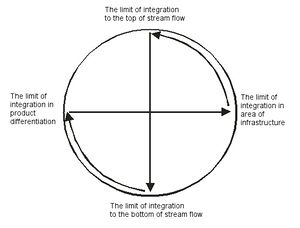Strategy wheel
Strategy wheel is a tool that helps companies develop strategies, it takes into account the problem of determining the boundaries of organization, and allows the simultaneous inclusion of each of the selected types of boundaries. It should be noted that from the standpoint of cooperation in the supply chain, this tool allow not only the determination of limits on a scale of one cell in chain, but also support the determination of boundaries between units.
Use of the strategy wheel should be preceded by a preparatory phase, in which relevant information about company's products is gathered. Information about current developments concerning the supply, manufacturing and distribution is also gathered.
Shown in fig. 1. is a simplified schematic presentation of the scope of activities that should be taken in connection with formulating the strategy of the company acting in the supply chain, as far as determining the boundaries and limits of that organization. The main tasks in this analysis include:
- Create list of offered products.
- Identify market requirements (customer needs).
- Estimate the degree of satisfying of the market expectations by the existing offer.
- Define existing knowledge, competences, experience and infrastructure, in terms of ability to meet customer expectations.
- Determine the limit for supply chain upstream flows (the range of tasks in the supply of raw materials and intermediates, which should be implemented independently, and the range of tasks that should be done by the contractors).
- Determine the ability of the company to carry out tasks that occur after delivery of the raw materials, semi-finished or finished products.
- Define the limit for downstream flows.
- Select an optimal range of products that will be offered by the enterprise.
- Establish goals for development of the necessary skills, experience and infrastructure.
See also:
Advantages of Strategy wheel
- Strategy wheel helps companies clearly identify the boundaries of the organization, making it easier to understand the scope of the business and its place in the supply chain.
- It facilitates the decision-making process by taking into account the different types of boundaries existing between the various elements of the chain.
- This tool allows companies to analyze the various opportunities and risks that come with entering into a partnership, joint venture, or other form of collaboration.
- This approach can help companies create an effective strategy that balances the interests of all stakeholders involved in the supply chain.
- The tool also enables companies to anticipate potential problems and better prepare for them.
- Strategy wheel can also be used to develop strategies for expanding the business by analyzing the market and the competition.
- This tool allows companies to optimize their operations and resources, making them more efficient and cost-effective.
Limitations of Strategy wheel
A strategy wheel is a powerful tool for companies to develop strategies, but it has some limitations. These include:
- It may not be applicable in all situations; for example, it may not be suitable for complex, large-scale projects.
- It does not take into account the internal and external environment of the organization, which may influence the strategy.
- The strategy wheel does not provide a solution to the problem of coordination between different departments and services.
- It cannot help organizations to anticipate the impact of their strategies on the market and the competition.
- It does not account for changes in the external environment that may affect the strategy.
- It may not be suitable for organizations facing rapid changes in the market.
- It does not take into account the resources available to the organization, which may limit the implementation of the strategies.
- Product Life Cycle Management (PLCM): This is a strategy which focuses on managing the product and its lifecycle, from its creation to its disposal. It considers all aspects of the product, including design, production, marketing, and distribution.
- Market Orientation: This approach focuses on understanding and responding to customer needs, as well as anticipating customer demand. It involves market research, customer feedback and analysis, and the use of this information to create strategies.
- Blue Ocean Strategy: This is a strategy which focuses on creating new markets and focuses on creating value by catering to unmet customer needs.
- Resource-Based View: This approach focuses on the resources and capabilities of an organization and how they can be used to create a competitive advantage.
- Strategic Leadership: This approach focuses on the role of leadership in strategy development and implementation. It emphasizes the importance of having an empowered and visionary leader who can create an environment for successful strategy execution.
In summary, Strategy wheel is a tool that can help organizations develop strategies by taking into account the problem of determining boundaries between units. Other approaches related to Strategy wheel include Product Life Cycle Management, Market Orientation, Blue Ocean Strategy, Resource-Based View, and Strategic Leadership.
| Strategy wheel — recommended articles |
| Innovation management — Knowledge gap strategy — Business concept — Wardley map — Strategic management — Importance of strategic management — Strategic planning — Organization life cycle — Ansoff strategy model |
References
- Kotorov, R. P. (2001). The strategy wheel: a method for analysis and benchmarking for competitive strategy. Competitive Intelligence Review, 12(3), 21-30.
- Mintzberg, H. (1987). Crafting strategy (p. 66-75). Boston, MA: Harvard Business School Press.
- Mintzberg, H. (1994). The fall and rise of strategic planning. Harvard business review, 72(1), 107-114.
- Philpott E., Hamblin D. J., Baines T., Kay G., (2004), The use of models and methods of strategic planning: Towards a holistic view of strategy, International Transactions in Operational Research, vol. 11, International Federation of Operational Research Societes, Blackwell Publishing Ltd.
